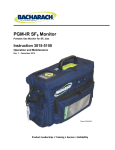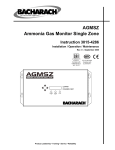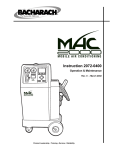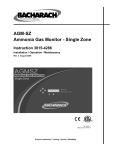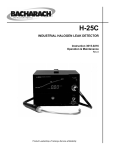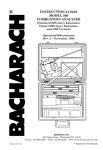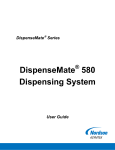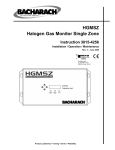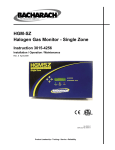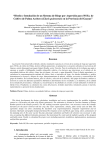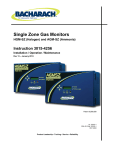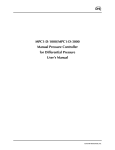Download Bacharach H-SEM Specifications
Transcript
H-SEM Halogen Safe Entry Monitor Instruction 3015-4584 Operation & Maintenance Rev. 0 – November 2005 Product Leadership • Training • Service • Reliability WARRANTY Bacharach, Inc. warrants to Buyer that at the time of delivery this Product will be free from defects in material and manufacture and will conform substantially to Bacharach Inc.'s applicable specifications. Bacharach's liability and Buyer's remedy under this warranty are limited to the repair or replacement, at Bacharach's option, of this Product or parts thereof returned to Seller at the factory of manufacture and shown to Bacharach Inc.'s reasonable satisfaction to have been defective; provided that written notice of the defect shall have been given by Buyer to Bacharach Inc. within two (2) years after the date of delivery of this Product by Bacharach, Inc. Bacharach, Inc. warrants to Buyer that it will convey good title to this Product. Bacharach's liability and Buyer's remedy under this warranty of title are limited to the removal of any title defects or, at the election of Bacharach, to the replacement of this Product or parts thereof that are defective in title. The warranty set forth in paragraph 1 does not apply to parts the Operating Instructions designate as having a limited shelflife or as being expended in normal use (e.g., filters). THE FOREGOING WARRANTIES ARE EXCLUSIVE AND ARE GIVEN AND ACCEPTED IN LIEU OF (I) ANY AND ALL OTHER WARRANTIES, EXPRESS OR IMPLIED, INCLUDING WITHOUT LIMITATION THE IMPLIED WARRANTIES OF MERCHANTABILITY AND FITNESS FOR A PARTICULAR PURPOSE: AND (II) ANY OBLIGATION, LIABILITY, RIGHT, CLAIM OR REMEDY IN CONTRACT OR TORT, WHETHER OR NOT ARISING FROM BACHARACH'S NEGLIGENCE, ACTUAL OR IMPLIED. The remedies of the Buyer shall be limited to those provided herein to the exclusion of any and all other remedies including, without limitation incidental or consequential damages. No agreement varying or extending the foregoing warranties, remedies or this limitation will be binding upon Bacharach, Inc. unless in writing, signed by a duly authorized officer of Bacharach. Register Your Warranty by Visiting www.bacharach-inc.com Notice: Product improvements and enhancements are continuous; therefore the specifications and information contained in this document may change without notice. Bacharach, Inc. shall not be liable for errors contained herein or for incidental or consequential damages in connection with the furnishing, performance, or use of this material. No part of this document may be photocopied, reproduced, or translated to another language without the prior written consent of Bacharach, Inc. Copyright © 2005, Bacharach, Inc., all rights reserved. ® BACHARACH is a registered trademark of Bacharach, Inc. All other trademarks, trade names, service marks and logos referenced herein belong to their respective owners. A Instruction 3015-4584 H-SEM Contents Table of Contents 1 INTRODUCTION ....................................................................................................................................... 1 1.1 How to Use This Manual.................................................................................................................. 1 1.2 Warning Statements......................................................................................................................... 1 1.3 Caution Statements.......................................................................................................................... 1 1.4 Hazard Symbols on Monitor............................................................................................................. 1 1.5 Safety Precautions ............................................................................................................................ 2 1.5.1 Explosive Atmosphere................................................................................................................ 2 1.5.2 Misuse and Modifications to Monitor ..................................................................................... 2 1.5.3 Altitude Limit............................................................................................................................. 2 1.5.4 Cleaning...................................................................................................................................... 2 1.6 Shipping Precaution ......................................................................................................................... 2 1.7 Unpacking and Initial Checks ......................................................................................................... 2 1.8 Features and Capabilities ................................................................................................................ 3 1.9 Functional Overview ........................................................................................................................ 3 1.9.1 General Description ................................................................................................................... 3 1.9.2 Response to the Presence of Multiple Refrigerants ................................................................. 3 2 SPECIFICATIONS..................................................................................................................................... 4 3 OPERATION.............................................................................................................................................. 5 3.1 Front Panel Display and Controls ................................................................................................... 5 3.2 Inspection .......................................................................................................................................... 5 3.3 General Operation ............................................................................................................................ 5 3.4 Battery – Testing and Charging ...................................................................................................... 6 3.4.1 Testing the Battery .................................................................................................................... 6 3.4.2 Charging the Battery............................................................................................................... 6 3.5 Display Screens................................................................................................................................. 7 3.5.1 Initial Power Up ......................................................................................................................... 7 3.5.2 Filling the Purge Air Bag .......................................................................................................... 7 3.5.3 Data Display Screen................................................................................................................... 7 3.5.4 Function Screens........................................................................................................................ 7 3.6 Standby Mode ................................................................................................................................. 10 3.7 Working with the Gas Alarm ......................................................................................................... 10 3.7.1 Gas-Alarm Light....................................................................................................................... 10 3.7.2 Silencing a Gas Alarm ............................................................................................................. 10 3.8 Working with System Faults ....................................................................................................... 10 3.8.1 Functional Overview................................................................................................................ 10 3.8.2 Clearing / Silencing a Fault Alarm ......................................................................................... 10 3.8.3 Viewing the Faults Log.......................................................................................................... 11 3.8.4 Fault Codes............................................................................................................................... 11 3.9 Clearing the PPM Log & Faults Log ............................................................................................. 12 3.10 Working with the DIAG Function ............................................................................................... 12 3.10.1 Overview ................................................................................................................................. 12 3.10.2 Keypad Functions .................................................................................................................. 12 3.10.3 First Diagnostic Screen.......................................................................................................... 12 3.10.4 Second Diagnostic Screen ...................................................................................................... 13 3.11 Working with the P-CHK Function ............................................................................................. 13 3.11.1 Overview ................................................................................................................................. 13 3.11.2 Keypad Functions .................................................................................................................. 13 3.11.3 Screen Display........................................................................................................................ 13 3.12 Entering Custom Refrigerant Calibration Values...................................................................... 14 3.13 Working with the Calibration Function ...................................................................................... 14 3.13.1 Calibration Procedure............................................................................................................ 14 3.13.2 Adjusting Calibration Factor................................................................................................. 14 Instruction 3015-4584 i Contents H-SEM 4 MAINTENANCE ...................................................................................................................................... 15 4.1 Disassembly .................................................................................................................................... 15 4.2 Internal Particulate / Hydrophobic Filter Replacement .............................................................. 16 5 PARTS AND SERVICE........................................................................................................................... 17 5.1 Replacement Parts ......................................................................................................................... 17 5.2 Service Centers............................................................................................................................... 18 ii Instruction 3015-4584 H-SEM Introduction 1 Introduction 1.1 How to Use This Manual This manual provides important information on how to operate and service the H-SEM (Halogen Safe Entry Monitor). To assure operator safety and the proper use of the monitor, please read, understand, and follow the contents of this manual. If you have a working knowledge of gas monitors, you will find this manual useful as a reference tool. If you are new to the use of gas monitors, you can educate yourself about the principles of gas detection and the proper operation of this device by reading this manual thoroughly. 1.2 Warning Statements The use of the word WARNING in this manual denotes a potential hazard associated with the use of this equipment. It calls attention to a procedure, practice, or condition, or the like, which if not correctly performed or adhered to, could result in personal injury or death. 1.3 Caution Statements The use of the word CAUTION in this manual denotes a potential hazard associated with the use of this equipment. It calls attention to a procedure, practice, condition, or the like, which if not correctly performed or adhered to, could result in damage to the equipment. 1.4 Hazard Symbols on Monitor This symbol indicates the need to consult this operating instruction manual when opening the enclosure. WARNING: A potential risk exists if the operating instructions are not followed. This symbol indicates the presence of electric shock hazards when the enclosure is opened. WARNING: To avoid risk of injury from electric shock, do not open the enclosure when power is applied. Instruction 3015-4584 1 Introduction H-SEM 1.5 Safety Precautions 1.5.1 Explosive Atmosphere Do not operate this equipment in the presence of flammable liquids, vapors or aerosols. Operation of any electrical equipment in such an environment constitutes a safety hazard. 1.5.2 Misuse and Modifications to Monitor The protection provided by the monitor may be impaired if the monitor is used in a manner not specified by these instructions. Changes or modifications to this monitor will void the warranty. 1.5.3 Altitude Limit 6,562 ft (2,000 m) 1.5.4 Cleaning To clean the outside of the case, DO NOT use soap and water. USE a dry cloth. 1.6 Shipping Precaution When shipping the instrument, deflate the purge-air bag to prevent it from bursting due to changes in air pressure. Deflate the bag by selecting the EMTYBAG function as described on Page 8. 1.7 Unpacking and Initial Checks Your Halogen Safe Entry Monitor was carefully inspected at the factory before shipment, and packed so as to be highly resistant to damage while in transport. When you receive the instrument, however, please unpack it promptly and make a visual inspection to make sure that no damage has occurred during shipment. Also check that all the following items have been received. Item Halogen Safety Entry Monitor External Inlet Filter Soft Carrying Case with Shoulder Strap Battery Pack & Charger Battery Charge Cable Instruction Manual Qty. 1 1 Part Number 3015-4484 3015-3420 1 3015-4474 1 1 1 3015-4654 3015-4405 3015-4584 If damage was found, immediately file a claim with the carrier. If an item is missing, please contact Bacharach’s Service Department for assistance (refer to Section Service Centers). 2 Instruction 3015-4584 H-SEM Introduction 1.8 Features and Capabilities • • • • • • • Detects and measures CFC, HCFC, HFC and halogen gases Measures all gases up to 1,000 ppm with a sensitivity of 1 ppm Automatically logs up to 200 gas readings that can be later be recalled for analysis Eliminates false alarms with use of non-dispersive IR source and sample draw system Visual and audible gas alarm indictors that are turned ON when the detected gas level exceeds a user defined trip-point Extensive self diagnostics, providing both visual and audible indications when a fault occurs Battery powered, providing from 8–12 hours of operation 1.9 Functional Overview 1.9.1 General Description The Bacharach Halogen Safe Entry Monitor (hereafter referred to as the H-SEM unit) is a portable refrigerant gas monitor with a self contained purge-air supply. The H-SEM unit is designed to test an area for a specific refrigerant gas for the purpose of determining the presence and level of that gas in the area being tested. The self contained purge-air supply allows an area to be tested for up to 40 minutes without needing to take the monitor to an area of fresh air for zeroing purposes. The monitor self-zeros every 4 minutes to ensure accurate gas measurements. During normal operation the H-SEM unit displays the type of gas being monitored, along with displaying both the current gas level and the peak gas level detected in that area on its front panel LCD. The monitor retains a log of previous readings that can be easily accessed at a later time for analysis. Front panel indicators and an audible alarm are provided to signal gas alarm and instrument fault conditions. The audible alarm can temporarily be silenced by a push of a button, but will reactivate if the gas level is still above the alarm trip point after a user defined time period has elapsed. The H-SEM unit requires only minor periodic maintenance such as the occasional replacement of filters. The monitor incorporates active diagnostics that continuously check the system for proper operation. A front panel indicator is provided to alert an operator of system malfunctions, and fault codes are generated that enable the operator to identify the cause of the fault. 1.9.2 Response to the Presence of Multiple Refrigerants The H-SEM is a refrigerant level monitor, not a gas analyzer. You must program the monitor to test for a specific refrigerant, and it will only return accurate concentration readings for that particular refrigerant. When other types of refrigerant gas are present, the monitor may return incorrect readings. Most applications only require detection of a single refrigerant and the problems that are associated with monitoring multiple gases are rarely an issue. If there is a possibility of multiple refrigerants leaking in the same sampling zone, then you should carefully consider which refrigerant compound you program the unit to monitor. Instruction 3015-4584 3 Specifications H-SEM 2 Specifications Product Type........................ Portable refrigerant gas monitor with built-in purge-air source Gas Library .......................... R-11, R-12, R-21, R-22, R-23, R-113, R-114, R-123, R-124, R-134A, R-227, R-236fa, R-401A, R-402A, R-402B, R-404A, R-407A, R-407C, R-408A, R-409A, R-410A, R-500, R-502, R-503, R-507, R-508B, H-1211, H-1301, H-2402, N-1230, FA-188, CUSTOM Measuring Range................. All gases 0 to 1,000 ppm Warm-Up Time .................... 15 minutes Operating Time.................... 40 minutes (approx.) before the purge-air bag needs refilling Detector Type....................... Infrared, Non-Dispersive Sensitivity ............................ 1 ppm Accuracy............................... ±1 ppm Response Time..................... 90% of response within 5 seconds; 100% in 7 seconds Temperature Drift............... 1.5 ppm per °C between purge cycles System Noise ....................... Less than 40dB(A) at 10 ft (3 m) Operating Temp................... 32 to 122°F (0 to 50°C) Ambient Humidity............... 5 to 90% RH (non-condensing) Altitude Limit ...................... 6,562 ft (2,000 m) Power.................................... DC power pack, provides 8–12 hours of operation Power Consumption ............ 15 Watts Front Panel .......................... 3 Indicator lights: ON – Green LED flashes during warm-up, and then glows steady during normal operation FAULT – Yellow LED flashes when there is a system fault ALARM – Red LED flashes when the gas level is above its alarm setting Audible Alarm ..................... Internal audible alarm programmable for any of the following conditions: OFF, FAULT/ALARM, ALARM Dimensions .......................... 8D x 19L x 5W inches (203 x 483 x 127 mm) Weight .................................. Less than 9 lbs (4 kg) including battery Valid Calibration Period to Specifications................... 12 months Warranty.............................. 2 Years from date of shipment 4 Instruction 3015-4584 H-SEM Operation 3 Operation 3.1 Front Panel Display and Controls DISPLAY SCREEN ALARM LIGHT (Red) SYSTEM FAULT LIGHT (Yellow) ENTER • Press to zero peak reading • When in the Control/Setup Menu Mode*, press to save a displayed value MONITOR ON LIGHT (Green) Flashes during warm-up KEYPAD When in the Control/Setup Menu Mode*, use these buttons: • To move the arrow (>) on the display screen to the desired function • Scroll through data • Change a function’s value SILENCE / ESC Press this button: • To temporarily silence the audible alarm • Return to the previous screen without saving data * Enter the Control/Setup Menu Mode by pressing the LEFT and RIGHT arrow buttons at the same time. Power ON/OFF Toggle Switch 3.2 Inspection The H-SEM unit has been thoroughly inspected and tested prior to shipment from the factory. Nevertheless, it is recommended that the monitor be re-checked prior to use. Inspect the outside of the enclosure to make sure there are no obvious signs of shipping damage. Open the enclosure and inspect the interior of the monitor for loose components that may have become dislodged during shipment. If damage is discovered, please contact your supplier for assistance. 3.3 General Operation WARNING: Operate the monitor in its horizontal position (handle facing upwards). Tilting the monitor to a vertical position while in operation may cause inaccurate measurements to occur. To turn ON the monitor, first lift up the shield located in front of the handle, and then press the red power ON/OFF toggle switch. Once the monitor has been powered ON, allow it to warm up for 15 minutes; after which, press the ENTER button to fill the purge-air bag with clean, fresh air that is of the same temperature and relative humidity as the area being checked for gas. DO NOT fill the purge-air bag in an area that is contaminated with refrigerant gas. After the purge-air bag has been filled, the monitor will automatically start making measurements in the area being sampled. The results of those measurements are displayed on the front panel display. MEASURE 00020pk 10ppm R134A Instruction 3015-4584 MEASURE indicates when the monitor is actively measuring gas. The screen to the left shows that currently 10 ppm of R-134A refrigerant gas is being detected, and that a peak measurement of 20 ppm has been made. The operator can reset the peak value to zero by pressing the ENTER button. The measurement cycle runs for 4 minutes. A log of up to 200 previous measurements can be viewed using the PPM LOG function (Page 8). 5 Operation H-SEM PURGE 00020pk 10ppm R134A PURGE AIR EMPTY <ENTER> TO FILL PURGE indicates when the monitor is resetting its infrared detector to a baseline of 0 ppm using the air stored in the internal purge-air bag. The purge cycle runs for 10 seconds. The monitor will operate approximately 40 minutes before the purge-air bag needs refilling. When the message "PURGE AIR EMPTY" appears, take the monitor to a clean, fresh-air environment and then press the ENTER button to refill the bag. If the detected gas level exceeds the preset gas-alarm point, the unit will respond by turning ON the front panel ALARM (red) light. If the AUDALRM function is activated (Page 8), the audible alarm will also turn ON. Pressing the front panel SILENCE button turns OFF the audible alarm, but the ALARM light will continue to flash as long as the detected gas level is above the alarm point. The audible alarm will reactivate if the gas-alarm condition is not cleared within the time period set by the SILENCE function (Page 9). If a system fault occurs (see Fault Code list on Page 11), the monitor responds by turning ON the front panel FAULT (yellow) light. If the AUDALRM function is activated (Page 8), the audible alarm will also turn ON. Pressing the front panel SILENCE button turns OFF the audible alarm, but the FAULT light will continue to flash as long as the fault is present. The audible alarm will reactivate if the fault condition is not cleared within the time period set by the SILENCE function (Page 9). Both the FAULT light and audible alarm will automatically turn OFF after the cause of the fault has been eliminated. A log of the last 30 fault events can be viewed using the monitor’s FAULTS function (Page 9). 3.4 Battery – Testing and Charging 3.4.1 Testing the Battery The monitor is powered by a rechargeable battery pack whose charge state can be checked by pressing its TEST button and observing the number of LEDs that light. A fully charged battery pack will power the monitor for 8-12 hours. A red flashing LED indicates that the battery pack needs to be charged. 3.4.2 Charging the Battery The battery pack can be recharged at any time, regardless of the battery’s current charge state. 1. Plug the charger’s AC line cord into any convenient 110/220 VAC, 50/60 Hz outlet. 2. Plug the charger’s output connector into the charge jack of the battery pack. For your convenience, a battery-charge cable is connected to the battery’s charge jack. This cable provides a battery-charge connector at the top of the soft carrying case, thus allowing the battery pack to remain inside the soft carrying case during charging. 3. Observe the following: 6 • The charger’s power indicator lights red while the battery pack is being charged. • The charger’s power indicator lights green when charging is complete. • Charging time is 3 to 4 hours for a fully discharged battery pack. Instruction 3015-4584 H-SEM Operation 3.5 Display Screens 3.5.1 Initial Power Up When the monitor is first powered up, all front panel lights turn ON and a splash screen appears showing the monitor’s current firmware revision level. After a brief moment the Warm Up screen is displayed along with the front panel ON light (green) blinking. BACHARACH WARM UP VERSION x.xx 900 The monitor requires 900 seconds (15 minutes) to warm up; after which, the ON light glows steady and the Data Display screen is displayed. 3.5.2 Filling the Purge Air Bag WARNING: Fill the purge-air bag in a clean, fresh-air environment that is at the same temperature and humidity as the area being checked for gas. DO NOT fill the bag in an area that is contaminated with refrigerant gas. The following message is displayed when the monitor’s purge air bag is empty and needs refilling. Press the ENTER button to start the refill process. After the air bag has been filled, the monitor will automatically resume normal operation. PURGE AIR EMPTY RECHARGING PURGE <ENTER> TO FILL AIR... 3.5.3 Data Display Screen MEASURE 00020pk PURGE 10ppm R134A 00020pk 10ppm R134A During normal operation, the Data Display screen shows when the monitor is performing the following two functions: MEASURE indicates that the monitor is actively measuring gas. In the screen shown above, 10 ppm of R-134A gas is currently being detected, and that a peak measurement of 20 ppm has occurred sometime in the past. The measurement cycle runs for 4 minutes. To reset the peak value to zero, press the ENTER button. PURGE is displayed when the monitor is resetting its infrared detector to a baseline of 0 ppm using the air stored in the internal purge-air bag. The purge cycle runs for 10 seconds. The monitor will operate for approximately 40 minutes before the purge-air bag needs refilling. 3.5.4 Function Screens The Function screens are used to display stored data and to set up the monitor. >FILLBAG EMTYBAG ALRMLVL AUDALRM >PPM LOG LOG INT FAULTS DIAG >SILENCE GAS P-CHK CLOCK >CUST K1 CAL CUST K2 CUST K3 Instruction 3015-4584 7 Operation H-SEM From the Data Display screen, press both the Keypad Left and Right buttons at the same time to display the first Function Menu screen. Next, use the Keypad buttons to move the arrow (>) through the menu screens until the arrow is next to the desired function, and then press the ENTER button to select that function. Once a function has been selected, use the Keypad to scroll through the displayed data or to change a parameter associated with that function. Press ENTER to save any newly entered parameters. Press the ESC button to return to the previous screen without saving. Note that if no buttons are pressed within 90 seconds after selecting a function, the unit returns to the Data Display screen. FILLBAG – Press ENTER to manually fill the purge-air bag. WARNING: Fill the purge-air bag in a clean, fresh-air environment that is at the same temperature and humidity as the area being checked for gas. DO NOT fill the bag in an area that is contaminated with refrigerant gas. EMTYBAG – Press ENTER to manually empty the purge-air bag. Use this function to drain the bag if it becomes contaminated with gas. ALRMLVL – Sets the detected gas ppm level at which the unit goes into an alarm state, as indicated by the front panel ALARM light turning ON. AUDALRM – Allows the monitor’s internal audible alarm to be associated with any function of the monitoring system. Factory default is OFF. Use the Keypad to select the desired audible alarm function, and then press ENTER to save that value and return to the previous screen. FILLING BAG... DRAINING BAG... EDIT ALARM LEVEL 0100 ppm AUDIBLE ALARM IS OFF Audible Alarm Settings: OFF, ALARM, ALARM/FAULT PPM LOG – Contains records of the last 200 measurements. Each record shows the measurement’s date, time, and ppm level. Measurements are logged at an interval determined by the LOG INT function (Page 8). #025 100PPM @ 06/07/05 15:35 1 Use the Keypad Up and Down buttons to change the record number by a factor of 1. Use the Right and Left buttons to change the record number by a factor of 10. Press ESC to return to the previous screen. To the right, record #025 shows that a level of 100 ppm was measured on 06/07/05 at 15:35. The PPM Log can be cleared as described under the heading Clearing the PPM Log & Faults Log on Page 12. LOG INT – Sets the interval at which measurements are logged to memory from 1 to 9999 minutes. Factory default is 1 minute. The logged measurements can be viewed using the PPM LOG function (Page 8). Use the Keypad to enter the desired value, and then press ENTER to save that value and return to the previous screen. DIAG – Enters the diagnostic function. Refer to the heading Working with the DIAG Function on Page 12. 8 LOG INTERVAL IS 0001 min 4.2159v <0000> 29.05cD 14.58psi Instruction 3015-4584 H-SEM FAULTS – Contains records of the last 30 fault events. The most recent event is displayed when the Fault screen is first displayed. After 30 events have been recorded, the newest record overwrites the oldest. Each record lists an event’s numeric fault code (refer to Working with System Faults on Page 10) plus the date and time at which the event occurred. Use any of the Keypad buttons to scroll through the other fault events. Press ESC to return to the previous screen. Operation #15 <1000> @ 06/07/05 12:37 To the right, record #15 shows that a Purge Flow Fault (fault code <1000>) occurred on 06/07/05 at 12:37. SILENCE – Sets the length of time the internal audible alarm is turned OFF when the front panel SILENCE button is pressed. The factory default is 300 seconds (5 minutes). If the cause of the alarm/fault has not been cleared at the end of this time period, the internal audible alarm is reactivated. Use the Keypad to enter the desired time period, and then press ENTER to save that value and return to the previous screen. P-CHK – This Pressure Check function displays the current manifold pressure and the stored ambient pressure in psia, along with the difference between these two pressures and the current fault code. Refer to the heading Working with the P-CHK Function on Page 13. GAS – Used to select of any one of 31 gas types plus one custom gas for monitoring. Factory default is R-134A. Note that the factory can program a custom gas type as specified on the sales order, or a custom gas can be programmed into the monitor at a later time using the CUST K1, K2, K3 function. Use the Keypad to select the desired gas type, and then press ENTER to save the selection and return to the previous screen. SILENCE TIMEOUT 0300 sec 14.59 AMB14.75 -0.16dif <0000> SELECT GAS TYPE R134A Gases Available for Selection: R-11, R-12, R-21, R-22, R-23, R-113, R-114, R-123, R-124, R-134A, R-227, R-236fa, R-401A, R-402A, R-402B, R-404A, R-407A, R-407C, R-408A, R-409A, R-410A, R-500, R-502, R-503, R-507, R-508B, H-1211, H-1301, H-2402, N-1230, FA-188, CUSTOM CLOCK – Sets the monitor’s date and time. Use the Keypad to enter the correct date and time, and then press ENTER to save those values and return to the previous screen. Note that time is displayed in a 24 hour format, while the date is displayed as mm/dd/yy. CAL – Used to change a calibration factor for a specific gas. Factory default is 1.000. Refer to the heading Working with the Calibration Function on Page 14. CUST K1, K2 & K3 – Used to enter custom calibration data for a blend of refrigerant gases that is not part of the monitor’s standard refrigerant gas library. Before using this function, the operator must contact the factory and provide information about the blend of refrigerant gases to be monitored. Custom calibration data will then be supplied to enable the monitor to accurately measure that particular gas blend. To enter this data, refer to the heading Entering Custom Refrigerant Calibration Values on Page 14. SET DATE & TIME 06/07/05 15:30 R134A CALFACTOR 1.000 CUSTOM CAL K^1 xxxx.xxx CUSTOM CAL K^2 yyyy.yyy CUSTOM CAL K^3 zzzz.zzz Instruction 3015-4584 9 Operation H-SEM 3.6 Standby Mode After the monitor has been turned ON and allowed to warm up, the monitor can be placed into a Standby Mode, ready for operation without waiting an additional 15 minutes before using. While in standby, the monitor will stop taking gas samples and purging itself from the internal purge-air bag. Place the monitor into its Standby Mode by pressing both the ENTER and ESC buttons at the same time. STAND BY Take the monitor out of standby by again pressing both the ENTER and ESC buttons. When the monitor is taken out of standby, the operator must refill the purge-air bag by pressing the ENTER button. Refilling the bag after coming out of standby re-establishes the monitor’s ambient pressure reading and ensures that the purge-air bag is filled at the start of taking gas measurements. WARNING: Fill the purge-air bag in a clean, fresh-air environment that is at the same temperature and humidity as the area being checked for gas. DO NOT fill the bag in an area that is contaminated with refrigerant gas. . PURGE AIR EMPTY RECHARGING PURGE <ENTER> TO FILL AIR... As soon as the purge-air bag has been refilled with fresh air, the Data Display screen appears and the monitor resumes normal operation. 3.7 Working with the Gas Alarm 3.7.1 Gas-Alarm Light If the detected gas level reaches the gas-alarm level as set by the ALARMLVL function (Page 8), the front panel ALARM light will flash and the audible alarm, if activated (refer to AUDALRM function Page 8), will start beeping. The ALARM light and audible alarm will automatically turn OFF once the detected gas level drops below the gas-alarm level. 3.7.2 Silencing a Gas Alarm Pressing the SILENCE button while the alarm circuit is activated causes the internal audible alarm to turn OFF for a period of time as set by the SILENCE function (Page 9). The front panel ALARM light will continue to flash, however, as an indication that an alarm condition still exists. The audible alarm will reactivate at the end of the silence period if the detected gas level is still above the gas-alarm level. 3.8 Working with System Faults 3.8.1 Functional Overview If a system malfunction occurs (see Fault Code list, Page 11), the front panel FAULT light will flash and the audible alarm, if activated (refer to AUDALRM function Page 8), will start beeping. 3.8.2 Clearing / Silencing a Fault Alarm The FAULT light and audible alarm will automatically turn OFF after the cause of the fault has been eliminated. Pressing the SILENCE button while a fault condition still exists causes the internal audible alarm to turn OFF for a period of time as set by the SILENCE function (Page 9). The front panel FAULT light will continue to flash, however, as a reminder that a fault condition still exists. The audible-alarm circuit will reactivate at the end of the silence period if the cause of the fault has not been corrected. 10 Instruction 3015-4584 H-SEM Operation 3.8.3 Viewing the Faults Log From the Data Display screen, press both the Keypad Left and Right buttons at the same time to display the first Function Menu screen. Next, use the Keypad buttons to move the arrow (>) until it points to the FAULTS function, and then press the ENTER button to display the Faults Log screen. #03 <0800> @ 07/11/05 08:17 #04 <0000> @ 07/11/05 09:00 FAULT CODE<1800> 12 SAMPLE FLOW FAULT CODE<1800> 13 PURGE FLOW The Faults Log screen shows the monitor’s current fault status. If the fault is still present when the FAULTS function is selected, then the current cause of the fault is displayed along with the date and time it occurred. If the cause of the fault has been cleared, then the Faults Log screen will show <0000> along with the date and time the fault was cleared. Use the Keypad buttons to scroll through the fault log. In the screens shown to the left, record #03 shows that a Sample Flow Fault (fault code <0800>) occurred on 07/11/05 at 08:17, while record #04 shows that the fault was cleared on 07/11/05 at 9:00. The cause of the fault is identified by a numeric fault code. To convert the fault code into a text description of the fault, first press the ENTER button and then use the Keypad buttons to scroll through the display until the text description of the fault appears. If the fault code is a combination of two or more faults, then continue to use the Keypad buttons until all fault text descriptions have been displayed. For example, the fault code <1800> represents the combination of both a Sample Flow <0800> and a Purge Flow <1000> fault as shown to the left. The Fault Log can be cleared as described under the heading Clearing the PPM Log & Faults Log on Page 12. 3.8.4 Fault Codes FAULT CODES ARE ADDITIVE. For example: A fault code of <0003> indicates that both a Box Temperature Fault <0001> and a Bench Temperature Fault <0002> have occurred. <0200> Gain Set Fault: The digipot autotune sequence has failed. This fault will only occur on first boot up or after a firmware upgrade. Call the factory for further instructions. <0001> Box Temperature Fault: Enclosure temperature is outside normal range (or IR detector has failed). Check that the monitor is not being subjected to extreme temperatures. Use the DIAG function to check the Box Temperature. <0400> A/D Fault: A fault has occurred in the analog-to-digital circuitry. Contact the factory with this information for further instructions. <0002> Bench Temperature Fault: Optical bench is outside normal operating range (or IR detector has failed). Check that the monitor is not being subjected to extreme temperatures. <0004> Manifold Pressure Fault: The manifold pressure is outside its normal operating range (or IR detector has failed). Enter the DIAG function and record ALL data. Call the factory with this information for further instructions. <0040> Fill Flow Fault: The purge-air bag’s pressure drop is outside expected limits. Check for a punctured bag or disconnected tubing. <0800> Sample Flow Fault: Check for: A restriction in the gas-sample inlet or exhaust; a blocked internal filter; or a failed pump. <1000> Purge Flow Fault: Check for: A restriction in the gas-sample exhaust; a blocked internal filter; or a failed pump. Once the purge air stream has been restored, the monitor will return to normal operation after it completes a purge cycle. <2000> Bag Fill Fault: The purge-air bag did not fill within the expected time allotment. Check for a punctured bag or disconnected tubing. <0080> Over Range Fault: Monitor exposed to a gas level that exceeded 65,000 ppm. <4000> Zero Range Fault: The IR detector’s output voltage is out of tolerance. Enter the DIAG function and record all data. Call the factory with this information for further instructions. <0100> Zero Filter Fault: The air-purge bag is contaminated with gas. Take monitor to a clean-air area and use the EMTYBAG and FILLBAG functions to decontaminate the air-purge bag. <8000> Clipping Fault: The detector voltage may be out of tolerance. Use the DIAG function to check the IR detector voltage. Call the factory with this information for further instructions. Instruction 3015-4584 11 Operation H-SEM 3.9 Clearing the PPM Log & Faults Log Up to 200 gas measurements, and 30 fault events are stored by the monitor. To clear stored data, first display the data to be cleared by selecting the PPM LOG or FAULTS function (Pages 8 & 9). Next, press both the ENTER and Keypad Right buttons at the same time. A single, long tone should be heard when the data has been successfully cleared. 1 3.10 Working with the DIAG Function 3.10.1 Overview The DIAG function displays sensor data and status information useful to a service technician for troubleshooting various fault conditions. Explanations of the data shown in these screens are given below. 3.10.2 Keypad Functions From the Data Display screen, press both the Keypad Left and Right buttons at the same time to display the first Function Menu screen. Next, use the Keypad buttons to move the arrow (>) until it is next to the DIAG function, and then press ENTER to display the first of two Diagnostic screens. Press the Keypad Up button to toggle between the First and Second Diagnostic screen. 3.10.3 First Diagnostic Screen 4.20885v <0000> Bench Voltage Fault Code 29.05cD 14.58psi Detector Temperature °C ∗ Pressure Reading 0.00075n Noise <0000> 35.40cB 14.59psi Box Temperature °C Fault Code ∗ Pressure Reading In the First Diagnostic screen, the user can toggle between displaying Bench Voltage / Detector Temperature, and Noise / Box Temperature by pressing the Keypad Right button. Bench Voltage – This is the current peak-to-peak output of the IR detector. In the absence of gas this value can range from 3.90000V to 4.50000V. Noise –The Noise value is a 16 point running average of the noise portion of the IR detector’s output. This reading is valuable mainly when gas is NOT present. Detector Temperature – This is the current detector temperature in °C. Box Temperature – This is the current internal enclosure temperature in °C. Fault Code – Current fault code. A value of <0000> indicates that no faults are being detected. Pressure Reading – This is the pressure as measured every purge cycle with the sample pump off and the gas-sample inlet open. Its value is weather and altitude dependent and can range from 10.0 to 15.5 PSIA. Purge Valve Asterisk (∗) – The purge valve can be opened and closed by pressing the Keypad Left button. An asterisk appears on the display when the purge valve is open causing the monitor to draw air from the purge-air bag. 12 Instruction 3015-4584 H-SEM Operation 3.10.4 Second Diagnostic Screen 0.1ppm 0.01 0.00004au 4.210v PPM Level Avg. Absorption Unit µMole/Liter ∗ Detector Voltage PPM Level – Parts Per Million Level is the current detected gas level, and is the volume concentration referenced to standard temperature and pressure. Average Absorption Unit – This is the optical absorbency. In the absence of gas the absorbency is 0.00000 au. When sampling gas, its value varies proportionally with the gas concentration. µMoles/Liter – This is the absolute concentration in micro-moles per liter of gas. Detector Voltage – This is a running average of the IR detector’s bench voltage. Purge Valve Asterisk (∗) – The purge valve can be opened and closed by pressing the Keypad Left button. An asterisk appears on the display when the purge valve is open causing the monitor to draw air from the purge-air bag. 3.11 Working with the P-CHK Function 3.11.1 Overview The P-CHK function (Pressure Check Function) (Page 9) is useful to a service technician for troubleshooting a flow-fault problem. The monitor will trigger a flow fault if the pressure drop from ambient is less than 0.2 psi during a purge cycle, and 0.5 psi during a measurement cycle. 3.11.2 Keypad Functions From the Data Display screen, press both the Keypad Left and Right buttons at the same time to display the first Function Menu screen. Next, use the Keypad buttons to move the arrow (>) until it points to the P-CHK function, and then press ENTER to display the Pressure screen. The Keypad Left button toggles the purge valve open and closed. Note that an asterisk (*) appears when the purge valve is open causing the monitor to draw air from the purge-air bag. The Keypad Down button toggles the pump ON and OFF. Pressing the ENTER button stores the current manifold pressure shown on the left to the ambient pressure shown on the right (must be done with the pump OFF). 3.11.3 Screen Display 14.59 AMB14.75 -0.16dif <0000> Current Manifold Pressure Pressure Difference ∗ Stored Ambient Pressure Fault Code Current Manifold Pressure – Current manifold pressure in psia. Stored Ambient Pressure – Stored ambient pressure in psia. Pressure Difference – The difference between the current manifold pressure and the stored ambient pressure. Fault Code – Current fault code (Page 11). Purge Valve Asterisk (∗) – The purge valve can be opened and closed by pressing the Keypad Left button. An asterisk appears on the display when the purge valve is open causing the monitor to draw air from the purge-air bag. Instruction 3015-4584 13 Operation H-SEM 3.12 Entering Custom Refrigerant Calibration Values CUSTOM CAL K^1 xxxx.xxx CUSTOM CAL K^2 yyyy.yyy In addition to the pre-programmed refrigerant gases available for selection, a custom gas can be added by using the CUST K1, K2 & K3 function. Before using this function, the user must contact the factory and provide information about the gas to be monitored. The factory will then supply values for K1, K2, and K3, which are the coefficients of a polynomial equation that represent the calibration curve of the custom gas. From the Data Display screen, press both the Keypad Left and Right buttons at the same time to display the first Function Menu screen. Next, use the Keypad buttons to move the arrow (>) until it points to the CUST zzzz.zzz K1 function, and then press ENTER to display the CUSTOM CAL K^1 screen. Use the Keypad buttons to enter the 1st coefficient value (K1) as received from the factory. Press ENTER to store this value. Repeat this procedure to enter the values for K2 and K3. CUSTOM CAL K^3 Select the custom gas for monitoring by using the GAS function (Page 9). 3.13 Working with the Calibration Function If greater than standard accuracy is desired, the factory’s default calibration factor of 1.000 may be adjusted by performing the calibration procedure as described below, and then selecting the monitor’s CAL function to enter the new calibration factor. IMPORTANT: Changing the calibration factor will VOID the factory calibration. Typically, the monitor will remain within the factory-calibrated accuracy indefinitely and no calibration is required. Complex software algorithms adjust for temperature drift, IR source aging, and pressure changes in order to keep the unit within factory accuracy specifications. 3.13.1 Calibration Procedure The calibration factor is determined by sampling a known concentration of R-134A refrigerant gas. A cylinder of a certified calibration gas must be used to ensure that the gas sample is a known concentration at ambient conditions. A minimum sample size of 5 liters is required. Calibration is best performed at or near full scale (1,000 ppm). It can, however, be done at any concentration and ideally in the range where maximum accuracy is desired down to, but not below, 100 ppm. The monitor should be operating for at least one hour prior to performing a calibration. Prepare the monitor for sampling by using the CAL function to set the calibration factor to 1.000. Also, use the LOG INT function to set the log interval to 1 minute. With the monitor operating normally, connect the gas-sample bag directly to the gas-inlet port and allow the monitor to sample the entire bag. When sampling is complete, view the logged ppm values using the PPM LOG function. If the bag was large enough for multiple samples, average the most stable ones. The new calibration factor is computed by dividing the known gas concentration value by the measured value. Typically this number will be between 0.95 and 1.05. Use the CAL function as described below to enter the new calculated calibration factor 3.13.2 Adjusting Calibration Factor R134A CALFACTOR 1.000 From the Data Display screen, press both the Keypad Left and Right buttons at the same time to display the first Function Menu screen. Next, use the Keypad buttons to move the arrow (>) until it is next to the CAL function, and then press ENTER to display the Calibration screen. With the Calibration screen displayed, use the Keypad buttons to enter the new calibration factor. Press ENTER to save this value. 14 Instruction 3015-4584 H-SEM Maintenance 4 Maintenance 4.1 Disassembly When servicing the parts inside the H-SEM unit, disassemble the monitor’s metal chassis as follows: Items Required: • Medium Phillips head screwdriver Procedure: 1. Remove monitor and its battery pack from the soft carrying case. 2. Unplug battery pack from monitor. 3. Remove a total of 10 screws from the locations shown in the illustrations below. 4. Carefully separate the metal enclosure, being careful not to puncture the purge-air bag. Instruction 3015-4584 15 Maintenance H-SEM 4.2 Internal Particulate / Hydrophobic Filter Replacement Items Required: • Replacement filter (07-1654) • Medium Phillips head screwdriver Procedure: 1. Disassemble the monitor’s metal chassis per Section 4.1. 2. See illustration below and locate the internal particulate / hydrophobic filter. 3. Pull off tubing from both ends of filter and remove filter from instrument. 4. Attach tubing to new filter, being sure to position the filter as shown in the illustration. 5. Reassemble monitor. 4.3 Flashing Memory An RS-232 connector, located on the top panel, is used to flash the monitor’s memory. This connector is for factory and service technician use only. 16 Instruction 3015-4584 H-SEM Parts and Service 5 Parts and Service 5.1 Replacement Parts Item Description Part Number Halogen Safe Entry Monitor ........................................................ 3015-4484 External Filter .............................................................................. 3015-3420 Internal Particulate Filter ........................................................... 07-1654 Battery Pack & Charger............................................................... 3015-4654 Battery Charge Cable................................................................... 3015-4405 Soft Carrying Case w/ Shoulder Strap ........................................ 3015-4474 Instruction 3015-4584 17 Parts and Service H-SEM 5.2 Service Centers Service and replacement parts can be obtained by contacting any of the following Bacharach Service Centers: United States México California Bacharach de México Playa Regatas No. 473 Tercer Piso Col. Militar Marte Delegación Iztacalco, 08830 México D.F. México Phones: +52-555-634-7740 +52-555-634-7741 FAX: +52-555-634-7738 Email: [email protected] 7281 Garden Grove Blvd., Suite H Garden Grove, CA 92841 Phone: 714-895-0050 Fax: 714-895-7950 Email: [email protected] New Jersey 7300 Industrial Park Rte. 130, Bldg. 22 Pennsauken, NJ 08110 Phone: 856-665-6176 Fax: 856-665-6661 Email: [email protected] Pennsylvania 621 Hunt Valley Circle New Kensington, PA 15068 Phone: 724-334-5051 Fax: 724-334-5723 Email: [email protected] Canada Bacharach of Canada, Inc. 250 Shields Court Unit #3 Markham, Ontario L3R 9W7 Canada Phone: 905-470-8985 Fax: 905-470-8963 Email: [email protected] 18 Europe European Headquarters Bacharach Instruments Sovereign House, Queensway Leamington Spa Warwickshire CV31 3JR United Kingdom Phone: +44-1926-338111 Fax: +44-1926-338110 Email: [email protected] Sales / Service Center - Denmark Bacharach Instruments Int'l P.O. Box 44 39 Lindegade DK 6070 Christiansfeld Denmark Phone: +45-74-563171 Fax: +45-74-563178 Email: [email protected] Instruction 3015-4584 H-SEM Parts and Service Notes: Instruction 3015-4584 19 Headquarters: 621 Hunt Valley Circle, New Kensington, PA 15068 PH: 724-334-5000 • Toll Free: 800-736-4666 • FAX: 724-334-5001 Website: www.bacharach-inc.com • E-mail: [email protected] Printed in U.S.A. ® Registered Trademark of Bacharach Inc.

























